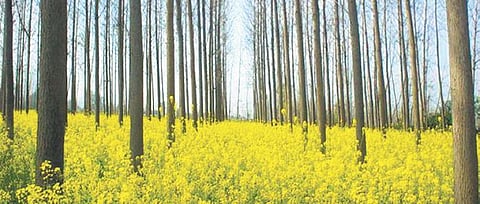

PUNJAB: For five years, 13,039 farmers across Punjab have been into agroforestry, which has emerged as one of the viable alternatives for diversification from the paddy-wheat cycle. In half a decade, 1.50 crore saplings have been planted, for which farmers have been given financial assistance through direct benefit transfer via Aadhar-linked accounts. Each farmer received the aid based on saplings planted by him in his fields. Survival of saplings was ascertained by geo-tagging.
The Union Ministry of Agriculture and Farmers Welfare began the Sub-Mission on Agroforestry (SMAF) in 2016-17 under the umbrella of National Mission for Sustainable Agriculture. The mission’s focus is to enhance the income of farmers and also diversify land use from agriculture to agroforestry.
Punjab has topped three states — the others are Gujarat and Karnataka — who implemented the scheme. It provides livelihood to marginal farmers by generating additional income from carbon credits. It has also resulted in better air and soil quality.
Saurabh Gupta, Additional Principal Chief Conservator of Forests and Nodal Officer, SMAF, says due to the successful implementation of the scheme, the tree outside forest (ToF) cover in the state has increased. This will help in achieving India’s Paris Agreement commitment to sequester 2.5-3 billion tons of additional carbon dioxide equivalents by 2020-2030.
“Some 40 lakh plants are targeted for plantation this year. Of these, around 7.65 lakh have been planted by more than 550 farmers. Over five years, financial assistance of about Rs 14.48 crore in a 60:40 ratio from the Centre and state has already been provided to eligible farmers,’’ he said.
“Timber grown under this project is reducing the pressure on natural forests. Availability of raw material is boosting wood-based industries in the state. Besides, employment has been created for locals as the project is labour-intensive. It also benefits the efforts for biodiversity conservation.”
Principal Chief Conservator of Forests, Punjab, VB Kumar said: “In addition to income generated from timber of the grown trees, the department is also launching a scheme to generate additional income for farmers from carbon credit market. The department is signing an MoU with TERI, a carbon market expert, to make arrangements capturing the carbon sink created by these agroforestry trees and trading in the carbon market.’’
Agroforestry has emerged as a viable alternative for diversification from existing rice-wheat rotation. The main fast-growing tree species adopted by farmers in their fields as block and boundary plantations are poplar, clonal eucalyptus, dek and shisam. The plywood industry in Punjab is mainly using timber of poplar and clonal eucalyptus. Dek and shisam are used by the furniture industry. “Farmers have a local market which provides good price,’’ says Aseem Kumar Singla, consultant of the state forest department.
Prem Chand, a farmer of Kalar village in SBS Nagar district, is a beneficiary of the scheme. He says he planted poplar trees in his six acres six years back. These plants are fully grown, giving him good returns. “Most people in my village have done these plantations as per their capacity and land. But one needs to take care of them as animals destroy these plants,” he says.